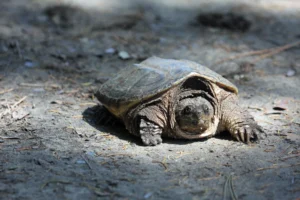Have you ever found yourself pondering the question, ‘Does a turtle have a backbone?‘ It’s a seemingly simple inquiry, yet its answer unveils a captivating exploration into the intricate biology of these remarkable creatures.
Yes, turtles do have backbones. In fact, like all vertebrates, turtles possess a backbone, also known as a vertebral column or spine. This backbone provides structural support and protection for the delicate spinal cord, which is a crucial component of the turtle’s nervous system.
From their renowned shells to their distinct adaptations, turtles have long fascinated both scientists and nature enthusiasts. Join me as we embark on a journey to uncover the truth behind this age-old mystery and delve into the fascinating world of turtle anatomy.
What Constitutes a Turtle Backbone?

Turtles have a unique skeletal structure that includes what is commonly referred to as their “backbone,” although it’s not exactly the same as the vertebral column in mammals. The main structural component of a turtle’s shell is the carapace, which is formed from modified ribs and vertebrae. Here’s how it works:
- Carapace: This is the top part of the turtle’s shell, often referred to as the “upper shell.” It’s composed of a series of bony plates called scutes, which are fused to the underlying skeleton.
- Vertebral column: Turtles do have vertebrae, but they are fused with the ribs and the carapace, forming a structure known as the “carapace framework.” This framework provides support for the shell and protection for the internal organs.
- Ribs: The ribs of a turtle are broad and flat, and they extend outward to form the framework of the carapace. They are connected to the vertebrae and are fused with the bony plates of the carapace.
- Plastron: This is the bottom part of the turtle’s shell, often called the “lower shell.” Like the carapace, it’s composed of bony plates and is fused with the ribs and other skeletal elements.
So, in essence, a turtle’s “backbone” includes the fused vertebrae, ribs, and the bony plates of the carapace and plastron. This unique skeletal structure provides excellent protection for the turtle’s vital organs while also allowing for some flexibility in movement.
Do turtles have backbones?
Yes, turtles do have backbones, although their skeletal structure is quite different from that of mammals.
The backbone, also known as the vertebral column or spinal column, is a fundamental part of the skeletal system in most animals, including turtles. However, in turtles, the backbone is modified and integrated into their unique shell structure.
The turtle’s shell is composed of two main parts: the carapace (top shell) and the plastron (bottom shell). These shells are made up of bony plates called scutes, which are formed from the fusion of the turtle’s ribs, vertebrae, and other skeletal elements.
The vertebral column of a turtle consists of a series of vertebrae, similar to those found in other vertebrates. However, in turtles, these vertebrae are fused with the ribs and other bones, forming a solid structure that provides support for the shell. This fusion of bones gives the turtle’s backbone its unique appearance and functionality.
So while turtles do have backbones, they are integrated into their shell structure in a way that is different from other animals, making them one of the most distinctive members of the reptile family.
Comparative Anatomy: Turtle vs. Other Vertebrates
Comparative anatomy between turtles and other vertebrates highlights both similarities and distinct differences. Here’s a brief overview:
- Skeleton:
- Turtles: Turtles have a unique shell composed of bony plates fused with the vertebral column, ribs, and other skeletal elements. Their limbs are adapted for walking, swimming, or both, depending on the species.
- Other vertebrates: Most other vertebrates have a more flexible vertebral column without a shell. Limb structure varies widely among vertebrates, from the four limbs of tetrapods (amphibians, reptiles, birds, and mammals) to the fins of fish.
- Respiration:
- Turtles: Turtles have lungs for breathing air but can also respire through cloacal bursae while underwater. Some species can even extract oxygen from water through their cloaca.
- Other vertebrates: Most vertebrates respire exclusively through lungs, though fish extract oxygen from water through gills.
- Reproduction:
- Turtles: Turtles lay eggs, typically burying them in nests for incubation. Some species exhibit temperature-dependent sex determination, where the temperature at which the eggs are incubated determines the sex of the offspring.
- Other vertebrates: Reproductive methods vary widely among vertebrates, from egg-laying to live birth. Mammals, for example, give birth to live young after internal gestation.
- Circulatory System:
- Turtles: Like other vertebrates, turtles have a closed circulatory system with a heart that pumps blood throughout the body. Their blood is oxygenated in the lungs.
- Other vertebrates: The basic structure of the circulatory system is similar across vertebrates, with variations in heart structure and blood composition.
- Nervous System:
- Turtles: Turtles have a central nervous system consisting of a brain and spinal cord, similar to other vertebrates. They also possess sensory organs such as eyes, ears, and tactile receptors.
- Other vertebrates: The nervous system varies in complexity among vertebrates, with mammals generally exhibiting more advanced cognitive abilities compared to other groups.
Overall, while turtles share many characteristics with other vertebrates, their unique shell structure and adaptations for an aquatic lifestyle make them distinct within the animal kingdom. Comparing their anatomy to that of other vertebrates provides insights into both the diversity and unity of life on Earth.
The Importance of the Turtle’s Backbone

The backbone, or vertebral column, of a turtle is of paramount importance for several reasons:
- Support and Protection: The backbone provides structural support for the turtle’s body, allowing it to maintain its shape and posture. In turtles, the backbone is fused with the ribs and forms the central framework of the shell, which provides crucial protection for the turtle’s internal organs against predators and environmental hazards.
- Mobility: While the turtle’s shell provides excellent protection, it can also limit mobility to some extent. The backbone plays a key role in facilitating movement by providing attachment points for muscles and ligaments. Despite the constraints imposed by their shell, turtles can move their limbs and neck to varying degrees, thanks to the flexibility provided by their vertebral column.
- Respiration: Turtles, like other vertebrates, require oxygen to survive. While turtles primarily respire through their lungs, the backbone also indirectly contributes to respiration by providing support for the muscles involved in breathing. Additionally, some aquatic turtles have evolved specialized adaptations, such as cloacal bursae, which aid in underwater respiration and are supported by the structures associated with the backbone.
- Reproduction: The backbone plays a crucial role in the reproductive process of turtles. Female turtles use their backbone to support and protect the developing eggs during ovulation and nesting. Additionally, the temperature-dependent sex determination mechanism observed in many turtle species relies on environmental factors affecting the development of the embryos within the eggs, which are laid and incubated in nests created by the mother.
- Sensory and Neural Function: The backbone houses and protects the spinal cord, a vital component of the central nervous system. The spinal cord is responsible for transmitting sensory information from the turtle’s body to the brain and coordinating motor responses. Thus, the integrity of the backbone is essential for maintaining proper sensory and neural function in turtles.
Overall, the backbone of a turtle is indispensable for its survival and adaptation to its environment. It not only provides support, protection, and mobility but also contributes to essential physiological functions such as respiration, reproduction, and sensory perception.
Conclusion
Does a turtle have a backbone? The answer is unequivocally yes. However, its skeletal structure is uniquely adapted to support and integrate with its iconic shell, composed of fused vertebrae, ribs, and other skeletal elements.
This backbone serves not only to provide structural support and protection but also plays crucial roles in mobility, respiration, reproduction, and sensory function. Thus, while distinct in its form and function, the turtle’s backbone is essential for its survival and adaptation in its environment.

